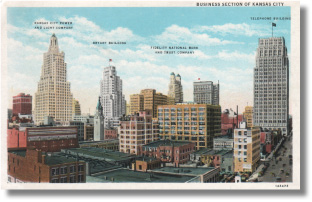
By MICHAEL BUSHNELL
Northeast News
This week’s postcard was published by the R.B. Harness Greeting Card Company of Kansas City, Mo. The view is described as the “Business Section of Kansas City” and seems to have been taken from near Truman Road and Oak Street, just south of the then-new City Hall and Jackson County Courthouse. It shows four prominent buildings completed or modified between 1928 and 1932.
At the far left is the Kansas City Power & Light building. Completed in 1931, it was for a time the tallest building in Missouri. The 31-story, pure art deco structure was capped by a 97-foot tower that at night, according to published reports, “glowed like a monstrous jewel.”
The next building is the “new” Bryant Building, another art deco tower built in 1931. The original Bryant Building was a seven-story one built in 1891 at the corner of Petticoat Lane and Grand Boulevard by Dr. John Bryant, on the site of his former home. After 40 years of use while downtown literally grew up around it, the original structure was razed for the new, 25-story art deco masterpiece that added an extra point to the growing skyline.
In the center-right of the card is the “new” Fidelity National Bank tower built in 1931 at the corner of 10th and Walnut. At the time of its completion, it was Kansas City’s second tallest building, more than 453 feet tall and only about 30 feet shorter than Power & Light. The clock, said to be the largest west of the Mississippi River, was installed in the original Fidelity Bank building in 1884. It continued to ring out the hours in the new building until 1972, when the great clock faces were dismantled and removed to prevent their plummeting to the street below – as it was feared they might.
The building on the far right is the Telephone Building at 11th and Oak. Hardly recognizable from its former self, it was built in 1920 as a 14-story structure. In 1928, 14 additional stories were added to the top, and in the late 1970s, the majestic old structure was horribly disfigured by a concrete veneer that covered its gargoyles and ornamental pediments. Preservationists throughout the city called it one of the darkest days for downtown when the new “skin” was applied to the historic structure. (This card was never mailed.)



















